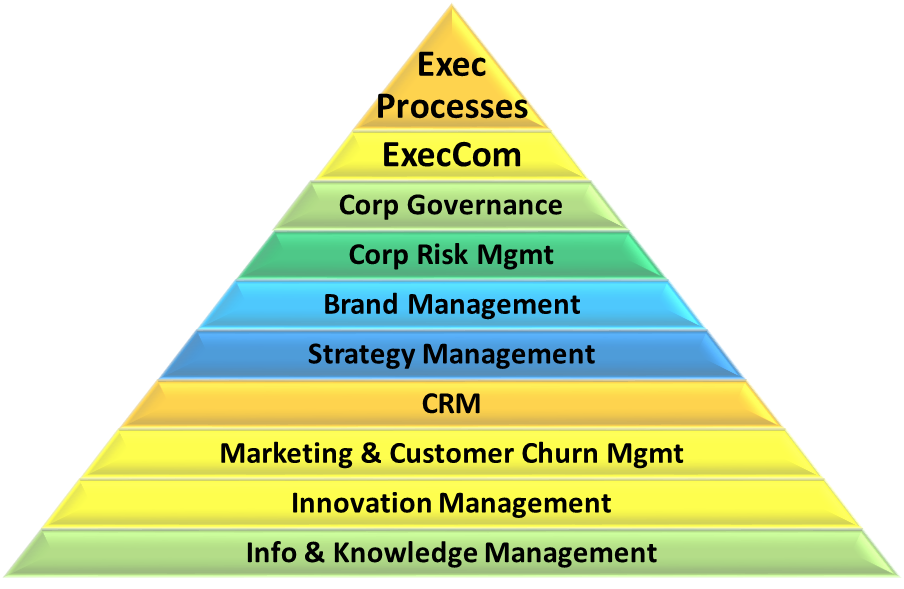 Executive Corporate Processes are generic processes aiming at safeguarding that the organization is effectively and efficiently governed and managed at all levels and are collectively executed. They are herein distinguished from ‘Management Processes/Duties’, which aim at safeguarding that ‘Line Managers’ at all levels carry out in a balanced way all their ‘Managing Duties’ and from ‘Corporate Core and Support Processes’, which aim at realizing the Corporate Mission.
Executive Corporate Processes are generic processes aiming at safeguarding that the organization is effectively and efficiently governed and managed at all levels and are collectively executed. They are herein distinguished from ‘Management Processes/Duties’, which aim at safeguarding that ‘Line Managers’ at all levels carry out in a balanced way all their ‘Managing Duties’ and from ‘Corporate Core and Support Processes’, which aim at realizing the Corporate Mission.
The Executive Committee comprises all or most CxOs. Wherever Anglo-Saxon company law applies, it is a corporate instrument aiming at strategic and tactical decision-making alignment, collective consultation and specific action/duty/project allocation. It does not imply collective responsibility. In countries where two-tier company law pervades, the Executive (or Management) Committee has collective decision-making powers and hence collective responsibility – while the Board of Directors acts as a Supervisory Council.
Modern ‘Governance’ theory and practice dictate that ‘Corporate Governance’ should not be limited to what is defined by “Corporate Governance Codes” but should be broader. It should be based on the formal (or informal) ‘Corporate Code of Ethics’ which comprises the ‘Corporate Values’ and their application and should define ‘Corporate Responsibility’. The latter supersedes ‘Corporate Social Responsibility’, which has been rightly ‘demoted’ to the level of ‘Public Relations’ and cannot ‘stand on its own’ outside the Corporate Code of Ethics.
A healthy organization should strive not only for short-term results but, simultaneously, for medium and long-term ones. Identification of long and short-term corporate threats and risks, development of strategies and plans to mitigate and/or manage them, executing plans and systematically reviewing results must be a formal Corporate Executive Process. Risk Management should be a formal process of both the Board of Directors and the Executive Committee and depending on the size of the Organization be supported (via advice, consulting and auditing) by a formal organizational unit. As a support sub-process it should be embedded in all core and support corporate processes and be line management responsibility.
‘Brand Management’ should be distinguished as an important part of ‘Culture Management’ and hence pervade all processes pertaining to all stakeholders: customers, employees, suppliers, partners, regulators, community...
‘Strategy Development’ must be a formalized process and be governed by Corporate Governance. It should be reviewed and revised regularly based not only on actual short-term results but also on long-term issues. It must be governed by the Corporate Vision and the Corporate Code of Ethics.
CRM must aim at satisfying short and long-term customer needs, service and contact and should strive for customer loyalty. It should be all-embracing and pervade the design, production, sales and after-sales support of products and services.
The Marketing process must be closely coupled with Sales and After-sales as must Marketing Campaigns do with all kinds of Customer Contact Centres. Up and Cross-selling must be coupled with Churn and Retention Management.
Process, Product and Service Innovation are a prerequisite for sustainability. Only through continuous innovation can an organization sustain competiveness and ideally a temporary monopoly which will secure its future health and reinvention for the sake of all its stakeholders and the community. Innovation must therefore be managed with the same rigour as all other executive, management and business processes.
All corporate, management and business processes are productively executed and managed through information. ‘Information’ becomes useful ‘Knowledge’, only when it is made available to and used by the organization’s people in carrying out their strategic and tactical duties. People without information are blind and information without ‘knowledgeable’ people is useless data. Being vital resources, information and knowledge need to be managed systematically.


